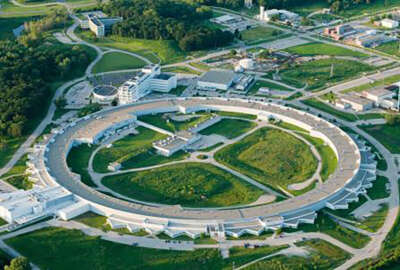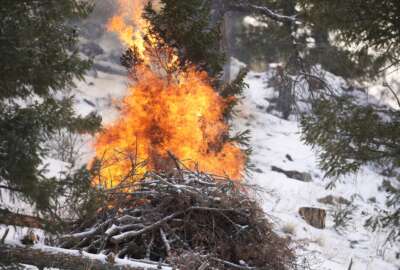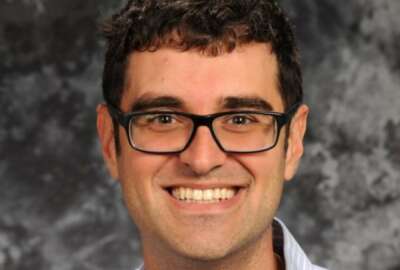Energy explores new way to harvest precious metals to help U.S. reserves
One planned pilot project, co-funded with industry by the Energy Department's Office of Fossil Energy, is in the works right now at Pacific Northwest National L...
Best listening experience is on Chrome, Firefox or Safari. Subscribe to Federal Drive’s daily audio interviews on Apple Podcasts or PodcastOne.
A clever idea to use magnetic nanoparticles to capture valuable materials from brine. Sounds arcane, but it’s blossomed into new projects that could help make the U.S. a producer, and not just a consumer, of critical minerals used in electronics and energy production. One planned pilot project, co-funded with industry by the Energy Department’s Office of Fossil Energy, is in the works right now at Pacific Northwest National Laboratory. For more, Federal News Network’s Eric White spoke with lab fellow Pete McGrail on the Federal Drive with Tom Temin.
Interview transcript:
Pete McGrail: Well, actually most of it comes from water, brine solutions from South America, so Chile, Argentina. So that’s primarily where it comes although there are some solid mineral extraction projects in Australia, China, etc.
Eric White: And so what is the idea behind this magnetic nanoparticles approach, and the idea of pulling, the materials out of the water through a more confined process, it seems?
Pete McGrail: Yeah, because conventional technology, you flow these brine solutions or evaporate them. That’s the main way it’s done today, you evaporate the water in these very massive evaporation ponds, and then precipitate the salts. So that water is lost. And that’s having impacts in South America, for example. So what we do is float this water through a extraction system, which uses nanoparticles. And it makes it much more efficient, cost effective to do the extraction, and we don’t lose any of the water, the water just gets recycled back underground. So we don’t have the the environmental impacts that current practices do.
Can you tell me a little bit about the core particle technology and what that entails and also, who contributed to creating it and whatnot?
Pete McGrail: Yeah, I can tell you some things about it. Of course, some of the nonproprietary information.
Eric White: Absolutely.
Pete McGrail: But basically, the idea here was really quite simple in the sense that what we’re doing is taking these nanoparticles, we put some chemical compounds, they’re called ligands, on the surface, and what we’re doing is introducing those particles into the brine solution, as it’s coming up from underground, from whatever source that may be. And then we let those particles interact at the molecular level with the lithium that’s present in small concentrations in the solution. So the special chemistry here is that we engineer the particles so that they’re very selective to pull the lithium out of these brine solutions, which have much, much higher. I mean, many orders of magnitude, higher concentrations of other elements in solution that we’re not interested in. So things like sodium and potassium. In some cases, it’s other elements like manganese, which are real problems in conventional technologies. So what the overall process concept is, is so taking these particles now that are very tiny, let them interact with the brine, pull the lithium out. And then once that’s happened, we pass them through a magnet so they’re magnetically susceptible, so they’re magnetic and we can pull them out of the solution with a magnetic extraction system, and then do the regeneration process. So now we’ve concentrated the lithium in these particles, and we can extract that and do the rest of the process steps which is purification mainly to provide battery grade lithium, and then that brine solution, which is now it has the lithium has been depleted, but is otherwise unaffected, can get reinjected back underground. And then our particles which didn’t have the lithium removed and then are regenerated, go right back to the top of the process and get recycled and reused over and over and over again.
Eric White: So yeah, so it seems as if there’s no wastewater process whatsoever like you see in other mining processes. Is that true you can just, put it right back in the ocean or hole or wherever you’re getting the water from?
Pete McGrail: Yeah, yeah, that’s exactly right. So we just want to make sure we can take that water solution, brine solution typically, and have that get reinjected back into ground so that we don’t have these regional impacts on groundwater systems that are occurring in areas like, Chile is a good example. So the major lithium producing region is called the Atacama. It’s actually one of the driest areas on the planet. And yet, what companies are doing today is extracting very large volumes of water underground, from this region, and putting it in these these massive evaporation ponds. And letting that, all that water get evaporated off into the atmosphere and lost. So the Chilean government is trying to limit any further applications of that kind of nascent technology. And so we think our system, much more economical, much faster, and certainly much more environmentally benign, can have great applications for future production in countries like Chile, but also here in the US, where we have similar kinds of issues. Where these brine solutions are being produced.
Eric White: And is the technology in the utilization stage yet? Or is it still experimental on a small scale? What’s the status of it?
Pete McGrail: Right, so we’re still at small scale in laboratories where we’re testing different formulations for these ligands, these chemical compounds that we’re using to extract the lithium, so we’re still at that stage. But we do a pretty good job in the lab in terms of taking these materials, we put them through the whole process through a magnetic separator, pull the lithium out, recycled and regenerate them, have a look at the, basically the entire process from start to finish. So we’re pretty confident. I mean, there’s always issues and taking technology from one lab scale up to a commercial scale. But, we’re doing the best we can right now at the lab scale to make sure we understand, all the aspects of the process, and then can move it to a pilot scale. When we were convinced, and our industry partners are convinced they’re ready, we’re ready to do that.
Eric White: So is it like in science class, when you’re making your own slime? And they have you drag a magnet into a pile of dirt and you pull out a bunch of little iron bits? Is that sort of what it looks like if we had a chance to zoom in on the process itself?
Pete McGrail: Well, thank you very much for bringing slime into the picture. But we’re not particularly interested in doing slime. But it is like a laboratory experiment here. Maybe a bit more sophisticated in net worth, we’re trying to monitor all the processes involved to make sure we can be confident in talking to various companies and investors about scaling up a process which is much more costly capital intensive to do compared to what we’re doing in the laboratory.
Eric White: Understood. And that’s a great segue for me to ask you to put your visionary hat on. If and when it gets large scale, what do you see? I mean, lithium is just being used more and more and everything. What could this change as far as where we actually get our lithium from for making all those important things that we’ve all become accustomed to?
Pete McGrail: Yeah, that’s a great question. So maybe most people don’t understand right now. But in terms of US supply, the vast majority of the lithium that is used for electric vehicles and battery storage, your cell phone, all of it, that is coming from overseas locations. So it’s coming from the major producing regions we talked about. So in South America, but producing the batteries is mainly being done in China right now. So the whole idea here is to say, well, you know, we have some very important U.S. domestic resources for lithium that aren’t being exploited at the moment. So these come from different places. So we have some geothermal areas, for example, in Southern California. So these are geothermal power plants normally, and what happens in those power plants is that the brine solution comes up, it’s hot, of course, to run a power plant, but it comes up from the surface, goes through the power plant, the heat is extracted and then the solution goes back underground. Well think about this, there’s thousands of gallons a minute of brine solution, that’s coming up from those locations, often it will have several 100 parts per million of lithium and solution, which can amount to actually a very large quantity of lithium, if we can extract it in that situation, economically, and not affect the power plant, etc. So we think our, our technology can apply in that circumstance. The one other situation domestically that looks important to us, is oil and gas production. So again, a lot of people may not realize this fact. But in terms of oil production, it’s actually a water producing operation. There’s normally on the order of even a 10 to even 100 barrels of water that are produced when we’re producing a barrel of oil. And it turns out that in a lot of situations, in producing oil and gas here in the U.S., we have lithium that is present in those solutions. So our calculations show that if we could get just a quarter of the lithium that’s in the water that’s produced as a consequence, it’s called produced water in the oil and gas industry, if we could get just a quarter of that, we could actually match the current world market for lithium production in the US. So these are very important, currently unexploited resources for lithium and we think new technologies like the one we’re talking about that we’re working on here at Pacific Northwest National Laboratory is a way to economically now provide those lithium resources that we really need for the renewable energy economy here in the U.S.
Copyright © 2024 Federal News Network. All rights reserved. This website is not intended for users located within the European Economic Area.
Tom Temin is host of the Federal Drive and has been providing insight on federal technology and management issues for more than 30 years.
Follow @tteminWFED






